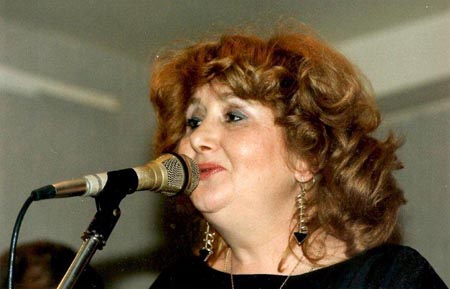
[Some computers might ask you to allow music to play on this page]
Rusty Taylor |

In our Profile of Steve Lane (click here), John Wurr looks back at the story of the cornet player and bandleader. As people read the page, memories came back of Steve's Famous Southern Stompers and the vocalists who worked with the band at various times - Pam White, Pam Heagren, Michelle Castell - and the 'Sophie Tucker style of Rusty Taylor.' So who was Rusty Taylor? 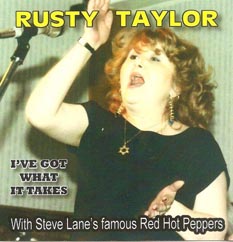 Sadly, Rusty died in 1993, but her husband, Kevin, helps us look back at the life of a singer who was very much part of the UK jazz scene:
Sadly, Rusty died in 1993, but her husband, Kevin, helps us look back at the life of a singer who was very much part of the UK jazz scene:
Rusty Taylor was born Ethyle Morris on 20th January 1941. Her roots were in the English Music Hall where both her father, Gus Morris, and his brother Dave were well known on the variety circuits in the '30s and '40s. Gus was lead comic in the travelling show Soldiers In Skirts, and Rusty's Uncle Dave had his own shows on TV and Radio. Her Aunt Ethyle was also stand-in for Mistinguett the famous French singer and dancer who was once married to Maurice Chevalier.
Rusty herself made her first public appearance in show business at the age of three months when she was carried on stage in a domestic scene by her father. By the age of two and a half years she was appearing in sketches in costume and make-up. She even appeared in Cabaret at the age of six and recalled her first encounter with jazz material at this time in the number Ballin’ The Jack.
Ethyle Cruden, as she was then known, worked regularly between 1955-1970 as a singer in the Working 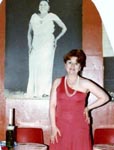 Men's Clubs and Cabaret in the North East of England. There she met Kevin Taylor, having previously separated from her first husband, John Cruden, in the summer of 1970. They married and subsequently moved to Windsor in the south of England, where Kevin was serving with the Household Cavalry.
Men's Clubs and Cabaret in the North East of England. There she met Kevin Taylor, having previously separated from her first husband, John Cruden, in the summer of 1970. They married and subsequently moved to Windsor in the south of England, where Kevin was serving with the Household Cavalry.
Modelling Bessie
Rusty’s first love was singing jazz and blues and she admired Bessie Smith, Sophie Tucker and many of the old Blues singers. She started singing with jazz bands in the south of England in 1971, with a local Windsor band called 'The 1066', and it was at this time, because of her red hair, she decided to call herself 'Rusty' Taylor. She worked with this band for a short time before being invited to join Steve Lane’s Southern Stompers in 1972 and during this period she had an album released on the Azure label called I‘ve Got What It Takes.
Here is a video of Rusty singing I've Got What It Takes recorded by Louis Lince at the Prince of Orange Rotherhythe, London, 9th August 1986 with: Ben Cohen (cornet), Bob Hunt (trombone), Keith Nichols (reeds), John Sirett (string bass/sousa), Jim Douglas (banjo), John Armitage (drums).
Rusty's second album with Steve Lane was under Rusty's name and came out with the title Good Old Bad Old Days, released on an American jazz label, Stomp Off (SOS 1028). By 1982, Steve Lane had changed the name of his band to the Red Hot Peppers. Here is Rusty singing Shine with the band:
However in 1975 her husband’s job took her to Europe, and at the suggestion of clarinettist Monty Sunshine, she joined a band in Hanover called Happy Jazz, working with them for a successful five years 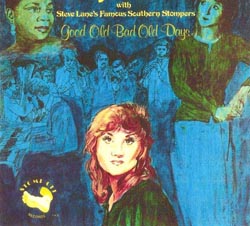 before returning to England in 1980. On her return, Rusty re-joined Steve Lane until in 1983 Rusty decided to go solo and form her own Band which she called 'Jazz Review'. and had a second solo album released on Stomp Off (SOS 1186 VOL 2) called Give Me A Call with Keith Nicols and Rusty Taylor’s Jazz Makers.
before returning to England in 1980. On her return, Rusty re-joined Steve Lane until in 1983 Rusty decided to go solo and form her own Band which she called 'Jazz Review'. and had a second solo album released on Stomp Off (SOS 1186 VOL 2) called Give Me A Call with Keith Nicols and Rusty Taylor’s Jazz Makers.
This album included lots of blues and had sleeve notes by Humphrey Lyttelton, in which he remarked “I have no difficulty in saying that Rusty Taylor’s work was good. What I will say off my own back is that this album is the best I have heard from her, and I have no doubt that, like me, you will listen to this album as one should listen to good jazz with a tapping foot, a deeply contented smile, a warm heart, and, from time to time, a moist eye.”
During this period, and at the same time as working with her own band who regularly played at the 100 Club in Oxford Street, Rusty also worked as guest singer with such names as Nat Gonella, Kenny Ball, Acker Bilk and Alan Elsdon. She also sang regularly with Kenny Baker in a Show called 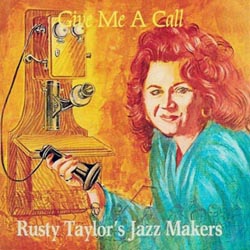 'An Evening With Bix And Bessie'. She was also starring in a show by John Petters called 'Queens of the Blues' with Beryl Bryden and Helen Gould, a show that was taken to Cork and other Jazz Festivals.
'An Evening With Bix And Bessie'. She was also starring in a show by John Petters called 'Queens of the Blues' with Beryl Bryden and Helen Gould, a show that was taken to Cork and other Jazz Festivals.
A 1985 American Jazzology Poll in America saw Rusty voted a tie in 36th place with such names as Cleo Laine, Blossom Dearie and Lena Horne. This resulted in Rusty being booked to sing with the Buck Creek Jazz Band in Baltimore where she blew the audience away with her singing in an event that received rave reviews. On a previous visit to New York the year before, Rusty stayed with Cynthia Sayer and sat in with the local band in Greenwich Village, with included Kenny Daverne, Howard Alden, Eddy Davis and Cynthia - to name but a few.
In 1987 Rusty decided to organise a Tribute to her friend Nat Gonella at the 100 Club in Oxford Street recognising his many years of contribution to British Jazz. This tribute turned into a wildly successful gig with many musicians and singers giving their services free. Many were household names including, Lonnie Donegan, the Tommy Burton Trio, Adelaide Hall, Beryl Brydon, the George Webb Band, the Alan Elson Band, Harry Gold, and many more. Roger Horton the owner of the 100 Club at the time was overwhelmed.
Rusty continued to tour Europe with her band over the next few years and had another album released on Stomp Off (SOS 1186 VOL 2) called 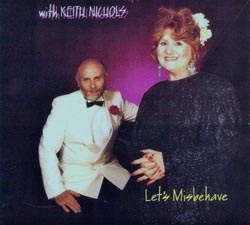 simply Let’s Misbehave. The album, a selection of very old, not generally known songs, combined her considerable talent with jazz pianist Keith Nichols and included such numbers as Cryin’ for the Carolines. Sleeve notes were by Chris Ellis who worked for EMI and who had a lot of praise for Rusty’s interpretation of the unusual songs on the album.
simply Let’s Misbehave. The album, a selection of very old, not generally known songs, combined her considerable talent with jazz pianist Keith Nichols and included such numbers as Cryin’ for the Carolines. Sleeve notes were by Chris Ellis who worked for EMI and who had a lot of praise for Rusty’s interpretation of the unusual songs on the album.
In the early 90’s Rusty, apart from singing with her own band, joined up with Harry Strutter’s Hot Rhythm Orchestra with Mike Cotton (trumpet), Bob Hunt (trombone), Tony Jack (clarinet), Bill Boston (saxophone), Martin Litton (piano), Maurice Denham (banjo & guitar), Jim Heath (sousa & bass and Eddie Maslow (drums). This was an extremely successful combination and was probably in competition with the Pasadena Roof Orchestra. All the gigs performed by this band proved popular and had wild appreciation with audiences. After Rusty's death a recording was made from a performance at The Quay Theatre in Sudbury, Suffolk and called simply Red Hot ‘N’ Rusty, the most notable number being Am I Blue with a terrific arrangement by Bob Hunt. Some of Rusty’s favourite composers were Dorothy Fields and Jimmy McHugh who wrote such songs as I Must Have That Man, Big Spender, I Can’t Give You Anything But Love and many more.
Rusty was also a regular visitor with her Band at the South Bank, and frequently at these gigs the Jiving Lindy Hoppers, who regularly worked with Harry Strutters Hot Rhythm Orchestra, would turn up and entertain the audience. Here she is singing Am I Blue with Harry Strutters:
In 1992, Rusty’s friend and member of Humphrey Lyttelton's Band, Bruce Turner, became seriously ill. As Rusty was living in the same town as Bruce she was able to visit him daily in Milton Keynes Hospital. A Benefit event for him was arranged by Roger 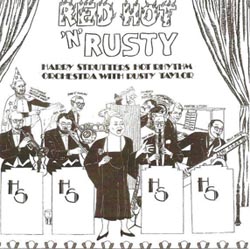 Horton at the 100 Club in Oxford Street, for Wednesday 17th November 1993. Rusty was booked to work with Acker Bilk for this gig. However in the early hours of Friday 12th November 1993, Rusty suffered a serious asthma attack and sadly died in Milton Keynes Hospital in the early hours of that morning.
Horton at the 100 Club in Oxford Street, for Wednesday 17th November 1993. Rusty was booked to work with Acker Bilk for this gig. However in the early hours of Friday 12th November 1993, Rusty suffered a serious asthma attack and sadly died in Milton Keynes Hospital in the early hours of that morning.
Rusty was a rising star, who was taken before she reached her full potential. She is sorely missed by the British and international jazz scene and their audiences today. Rusty left us a legacy in her music, which audiences still enjoy today. The key to Rusty’s success as a jazz and blues singer was not only in the material that she sang, but when singing, every word could be understood and her timing was perfect.
All the musicians she used were true professionals, “sympathetic” in timing and volume. Rusty also encouraged audience participation, especially in her well known rendition of Cake Walkin’ Babies. She has been sadly missed since her death in 1993 and the like of her will rarely be seen again on the British Jazz scene.
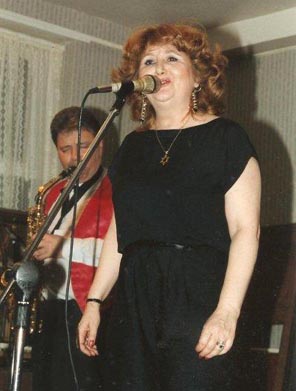
Other Profiles / Articles that might be of interest
Click HERE to join our mailing list
© Sandy Brown Jazz 2016 - 2017